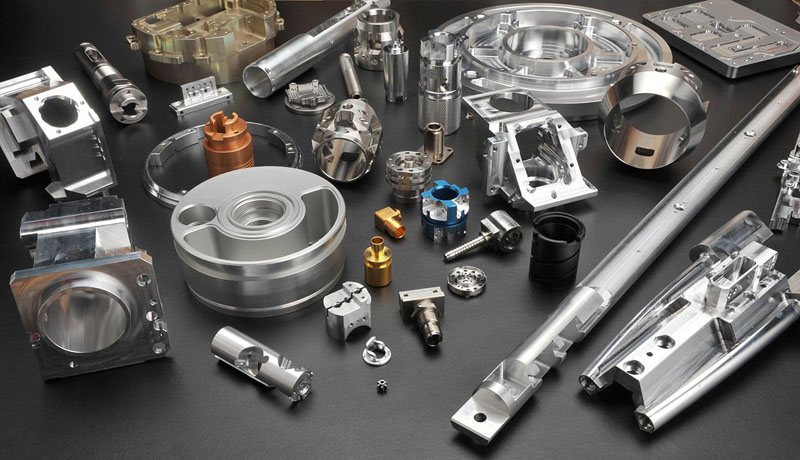In the world of CNC machining, there is no such thing as a one-size-fits-all approach. A set of parameters that produces a mirror finish on aluminum will destroy a cutting tool in seconds when applied to titanium. The fundamental properties of a material—its hardness, thermal conductivity, ductility, and tendency to work-harden—dictate every aspect of the machining strategy.
Understanding how to adapt your approach to the specific material on your machine is the hallmark of a skilled machinist. It is the key to achieving superior quality, maximizing efficiency, and preserving tool life. This guide outlines the essential considerations and key strategies for successfully machining the most common material families.
1. Carbon & Alloy Steels (The Workhorses)
Steel is the most common material found in machine shops, but its behavior can vary dramatically based on its carbon content and heat-treated condition.
Material Behavior: Steels are characterized by their strength and toughness. Low-carbon (“mild”) steels are relatively soft and can produce long, stringy chips. Higher-carbon and alloy steels (like 1045 or 4140) are harder and more abrasive, generating more heat and tougher chips.
Key Machining Strategies:
- Rigidity is Paramount: Steel requires high cutting forces. A rigid machine, robust workholding, and short tool overhangs are essential to combat vibration and maintain accuracy.
- Heat and Chip Management: Use a high-quality flood coolant to dissipate heat and effectively flush chips away from the cutting zone. For tougher alloy steels, chip-breaker geometries on turning inserts are critical to manage the strong, hot chips.
- Tooling: Coated carbide is the industry standard. A coating like Aluminum Titanium Nitride (AlTiN) provides excellent heat and wear resistance.
- Speeds and Feeds: Use moderate cutting speeds but maintain a consistent, positive feed rate. “Rubbing” the tool by feeding too slowly will cause friction, generate excess heat, and lead to premature tool wear.
2. Aluminum Alloys (The High-Speed Specialist)
Aluminum is prized for its lightweight properties and excellent machinability, but its softness presents unique challenges.
Material Behavior: Aluminum is soft, has high thermal conductivity, and is notoriously “gummy.” This leads to its primary challenge: Built-Up Edge (BUE), where material welds itself to the tool’s cutting edge, ruining the surface finish and tool life.
Key Machining Strategies:
- Speed is King: The number one rule for aluminum is to use very high cutting speeds (SFM or m/min). This allows the tool to shear the material cleanly before heat can build up and cause BUE. The high thermal conductivity means most of the heat is effectively evacuated in the chip.
- Aggressive Chip Evacuation: Aluminum produces a high volume of chips. High-pressure, high-volume coolant or a powerful air blast is crucial to clear chips instantly and prevent them from packing in tool flutes, which can lead to tool breakage.
- Aluminum-Specific Tooling: Use end mills with fewer flutes (typically 2 or 3) to provide maximum space for chip evacuation. The flutes should be highly polished, and the cutting edges razor-sharp.
- The Right Coating (or Lack Thereof): Uncoated, polished solid carbide tools are often the best choice. If a coating is used, it must be extremely slick and non-ferrous specific, such as Zirconium Nitride (ZrN) or Diamond-Like Carbon (DLC). Avoid standard TiAlN coatings, which have a chemical affinity for aluminum.
3. Stainless Steels (The Tough & Gummy Challenge)
Stainless steels are known for their corrosion resistance, but they are among the most difficult materials to machine due to a problematic combination of properties.
Material Behavior: Stainless steel has high toughness, a strong tendency to work-harden, and very low thermal conductivity. This means heat does not escape in the chip; instead, it concentrates directly at the tool’s cutting edge.
Key Machining Strategies:
- Combat Work Hardening: Never allow the tool to dwell or rub against the workpiece. A constant, aggressive feed rate is non-negotiable. Once a surface is work-hardened, it can become nearly impossible to cut.
- Aggressive Cooling: Use high-pressure flood coolant aimed directly at the cutting zone to combat the extreme heat buildup at the tool tip.
- Lower Cutting Speeds: Compared to carbon steel, cutting speeds must be significantly reduced to manage the intense heat and prevent the tool from burning up.
- Sharp, Positive-Rake Tooling: Use tough carbide grades with a very sharp, positive cutting edge to shear the material cleanly rather than plowing through it.
- Manage Tough Chips: The chips are incredibly tough and stringy. Use inserts with aggressive chip breakers and consider peck drilling cycles to break chips and allow coolant to reach the cut.

4. Titanium Alloys (The Heat-Resistant Expert)
Titanium offers an incredible strength-to-weight ratio, but it is an exceptionally challenging material to machine, primarily due to its thermal properties.
Material Behavior: Titanium is a very poor thermal conductor—even worse than stainless steel. It retains its strength at high temperatures, which means the heat generated during cutting is almost entirely absorbed by the tool. It is also prone to work hardening and can react chemically with the tool material.
Key Machining Strategies:
- Heat is the Absolute Enemy: Every aspect of the strategy must focus on minimizing heat generation.
- Low Cutting Speeds: This is the most critical rule. High speeds will cause instantaneous tool failure.
- Maintain Chip Load: While speeds are low, maintain a consistent and relatively high feed rate. This ensures a thick chip is formed, which helps carry some heat away.
- Sharpness is Paramount: Use the sharpest possible carbide tools with a positive rake. As soon as an edge shows any sign of wear, it must be replaced.
- High-Pressure Coolant is Mandatory: A high-volume, high-pressure flood of coolant is required not only to cool the tool but also to prevent titanium chips from igniting, as they are flammable under the right conditions.
5. Engineering Plastics (The Low-Temp Specialist)
Plastics are a diverse group, but they share common machining challenges related to their low melting points and flexibility.
Material Behavior: Plastics have low thermal conductivity and a low melting point. The heat generated by cutting doesn’t dissipate; instead, it can cause the material to melt, gum up the tool, and produce a poor finish. They can also be flexible and prone to vibration, or highly abrasive if filled with glass or carbon fiber.
Key Machining Strategies:
- Avoid Melting: Use extremely sharp cutting tools (often with geometries similar to those for aluminum, such as “O-flute” end mills) to shear the material cleanly with minimal friction.
- Clear Chips Immediately: Chips must be evacuated instantly to prevent them from melting and re-welding to the surface. A strong air blast is often preferred over liquid coolant to avoid thermal shock and part contamination.
- Careful Workholding: Use reduced clamping pressure to avoid deforming or marring the part.
- Beware Abrasive Fillers: For glass- or carbon-filled plastics, expect very high tool wear rates. Diamond-coated or solid carbide tooling is necessary to achieve a reasonable tool life.
Conclusion
Mastery in CNC machining lies not in knowing a single “best” way to cut, but in understanding that every material presents a unique puzzle. By tailoring your tooling, parameters, and cooling strategy to the specific behavior of the material at hand—be it the strength of steel, the gumminess of aluminum, or the thermal sensitivity of titanium—you can transform a challenging job into a successful, high-quality, and profitable outcome.



